[Bianculli here: Instead of taking the annual PBS summer holiday concerts for granted, contributing writer Tom Brinkmoeller goes to the source to ferret out all sorts of facts, figures and back-stage anecdotes -- just in time for Memorial Day...]
Thirty Years In, Annual PBS Holiday-Concert Broadcasts Stay Fresh and Viewer-Friendly
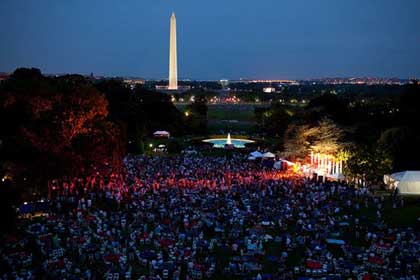
There are several reasons why PBS' broadcasts of the annual Memorial Day and July 4th concerts from the lawn of the U.S. Capitol are so popular. They're traditions: The first July 4th telecast was in 1981 and the first Memorial Day concert was broadcast nine years later.
They mark summer holidays in an American-made manner: A concert, touching memorials, patriotic speeches, spectacle and fireworks. And each year it is a first-class, 90-minute production.
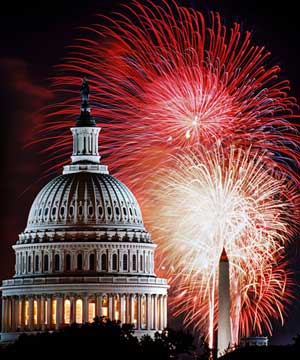 And, of course, they're noncommercial -- always kind of odd when a touching moment on commercial TV segues into a Pepto Bismol or a Viagra commercial.
And, of course, they're noncommercial -- always kind of odd when a touching moment on commercial TV segues into a Pepto Bismol or a Viagra commercial.
But the fact that they're live telecasts has to be one of the big draws for many. They happen outside, no matter what the weather. Hundreds of thousands of people gather to watch. The orchestra and the guest stars perform without the safety net recording and editing usually provides. People aren't watching for mistakes. The excitement is watching as something happens. It's similar to watching an artist put paint on canvas. Live broadcasts are rare events anymore, and when they're done well, it shows natural is even more attractive than the polish applied in an editing bay.
Executive Producer Jerry Colbert was 37 when he came up with the idea for the original broadcast, and 30 years later he's still happily at it. He recently shared some facts and stories about the two concerts, which are scheduled as follows:
National Memorial Day Concert (May 30, 8-9:30 p.m. ET, rebroadcast immediately following; check local listings).
A Capitol Fourth: America's Independence Day Celebration (July 4, 8-9:30 p.m. ET, rebroadcast immediately following; check local listings).
FIRST, SOME NUMBERS
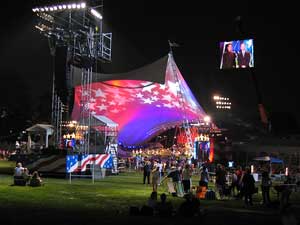
About 500 people work on the shows. It takes 54 trucks to deliver all the needed materials to the Capitol's West Lawn twice each summer. There are 18 cameras used for the July 4th telecast and 10 for Memorial Day. Each requires more than 200 microphones. The two programs are PBS' highest rated performance shows. More than 100,000 people show up to watch the dress rehearsals. Between 300,000 and 400,000 people attend the actual live broadcasts. Colbert and company deal with 22 different agencies each year to get clearances and coordinate permissions for the concerts.
"Every (agency) has their own cultures," Colbert said. "and in the cultures, they have their own rules. That's a lot of different groups to bring together."
His son, Michael, who is executive vice president of Colbert's Capital Concerts, takes primary responsibility for dealing successfully with all these agencies.
EQUIPMENT HISTORY
Colbert said the truck used as control room for the first concert reminded him of a bookmobile. The control console was temperamental: The person who delivered it had to pound on it three times with the palm of his hand before it finally turned on. But he assured Colbert that once it was on, it wouldn't unexpectedly turn off.
Colbert called the first tent, under which hosts, performers and orchestra performed, "the bikini," because it was so small. So small, he said, that a rain during one early concert was so intrusive that 36 of the 40 violinists walked off the stage -- while "the conductor pleaded with them to stay." The tent was revised five times, he said, before one was made that keeps everyone dry in a storm.
There was no teleprompter for the first broadcast. Host E.G. Marshall had a clipboard of notes, which he'd review and commit to memory immediately before he went on camera again.
PREPARATION
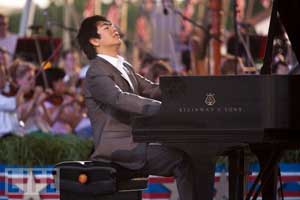
Planning starts in September. Colbert travels to Los Angeles for the first of several meetings with directors and other key technical people who have years of experience in producing live television. These key people regularly are called on for awards shows like the Tonys, Country Music Association, People's Choice, Golden Globes and Emmys.
Walter C. Miller, who used to direct the holiday telecasts, now actively produces each show from a key vantage point on the stage. His son, Paul Miller (whose credits include Saturday Night Live, In Living Color and the Tony Awards), took over the director's chair in 1993.
The closer the performance date, the more intense the activity: mid-week meetings; a rehearsal at the Kennedy Center for the Performing Arts; the previously mentioned dress rehearsal before a huge audience; and countless revisions, rewrites and polishes along the way.
PEOPLE
Most of the talent, Colbert said, are truly into the spirit of the events, and the concessions they take in fees helps to keep the costs down. But artists' temperaments aren't always in-check. Like the pop group that showed up for the rehearsal, saw the size of the audience and demanded double the pay. They claimed they were doing two shows. That same group had a member who decided he'd rather play golf than rehearse. He tried to convince Colbert that a member of the group's entourage knew all his musical parts and could fill in nicely.
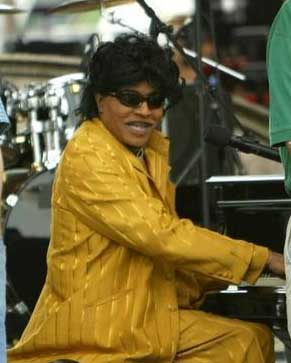
When Little Richard performed, "he wouldn't tell us what (songs he was going to do)," Colbert said. "He told us, 'I just got to get the feel.'"
And in a very early performance, guest artist Pearl Bailey and National Symphony Orchestra Conductor Mstislav Rostropovich were already legends in their own musical circles, but neither knew a thing about the other, Colbert said, leading to some awkward moments. He remembers the look on Rostropovich's face when Bailey ad-libbed at the end of a number, "Play it again, Maestro."
WARM FEELING
Twice, Colbert said, members of Congress who were in the Memorial Day audience introduced veterans' funding legislation after seeing show segments, one on homeless veterans and another on vets' traumatic brain injuries.
Once the final concert is over, Colbert retreats to a home on Cape Cod, where he reads as many as 500 letters from viewers who wrote to share stories of their family's military experiences and other personal notes sent in appreciation.
"It just makes you feel good," he said.
Labor Day marks the end of summer and of Colbert's down time. That's when he leaves the Cape and travels to Los Angeles to start the process over again.